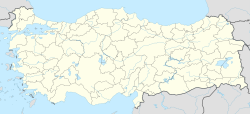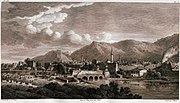Анкайя
Анкайя | |
|---|---|
По часовой стрелке сверху : Вид с видом на Антакья, церковь Святого Павла , мечеть Хабиб-и Неккар, Церковь Святого Петра , Мечеть Антакья Улу | |
 Карта, показывающая район Антакья в провинции Хатай | |
| Координаты: 36 ° 12′09 ″ с.ш. 36 ° 09 ′38 ″ E / 36,20250 ° N 36,16056 ° E | |
| Правительство | |
| Область | |
| • Общий | 703 км 2 (271 кв. МИ) |
| Возвышение | 67 м (220 футов) |
| Население (2022) [ 1 ] | |
| • Total | 399,045 |
| Area code | 0326 |
| Website | www |
Антакя ( Турецкое произношение: [ɑnˈtɑkjɑ] ; Местный турецкий : Антеке [ 2 ] ), современная форма антиохии ( древнегреческий : ἀντιόχεια , Романизированный : Антиокгейя ; Армян : անտիոք , Романизированный : Андиок ; Латинский : Антиохия ), является муниципалитетом, а столичный район провинции Хайей , Турция . [ 3 ] Его площадь 703 км 2 , [ 4 ] и его население составляет 399 045 (2022). [ 1 ] Это столица провинции Хатай, самая южная провинция Турция. Город расположен в хорошо обладанной и плодородной долине на реке Оронтс , примерно в 20 километрах (12 миль) от Левантинского моря .
Сегодняшний город частично стоит на месте древней Антиохии ( древнегреческий : ἀντιόχεια , антиохейя , также известный как «Антиохия на Оронте»), которая была основана в четвертом веке н.э. до Позже Антиохия стала одним из крупнейших городов Римской империи и стала столицей провинций Сирии и Коле-Сирии . Это был также влиятельный ранний центр христианства ; [ 5 ] Новый Завет утверждает, что название «Кристиан» впервые появилось в Антиохии. [ 6 ] Город приобрел очень церковное значение в Византийской империи . Захвачен Умаром ибн аль-Хаттабом в седьмом веке, средневековая антакия ( арабский : أنطاكية , ʾanṭākiya ) был завоеван или повторно зарегистрирован несколько раз: византийцы в 969 году, сельджуки в 1084 году, [ 7 ] Крестоносцы в 1098 году , [ 8 ] Мамлуки в 1268 году , [ 9 ] и в конечном итоге османы в 1517 году, [ 8 ] Кто будет интегрировать его в Aleppo Eyalet, тогда в Aleppo Vilayet . Город присоединился к штату Хайэй под французским мандатом, прежде чем присоединиться к Турецкой Республике .
6 февраля 2023 года город был сильно поврежден двумя могущественными землетрясениями со своим эпицентром в Кахраманмараша . Некоторые из исторических мест, в том числе Церковь Святого Павла , были уничтожены. [ 10 ] Землетрясения уничтожили несколько районов города и оставили тысячи бездомных. Число погибших в провинции Хатай, которая включает в себя Антакья, оценивалась в более чем 20 000 человек. [ 11 ]
История
[ редактировать ]
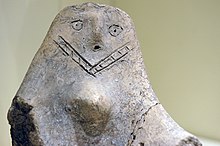
Древность
[ редактировать ]Люди занимали область антиохии со времен халколита ( 6 -е тысячелетие до н.э. ), как показано археологическими раскопками Алалаха , среди прочих. [ Цитация необходима ]
The Macedonian King Alexander the Great, after defeating the Achaemenid Empire in the Battle of Issus in 333 BCE, followed the Orontes south into Syria and occupied the area. The city of Antioch was founded in 300 BC, after the death of Alexander, by the Seleucid emperor Seleucus I Nicator.[citation needed] Он сыграл важную роль в качестве одного из крупнейших городов в Селеуцидах, Римской и Византийской империи. Город поменялся руками между византийцами и Сасанской империей в 3 -м веке . Это было полем битвы для 253 осады Антиохии , когда Шапур я победил римскую армию и более позднюю битву Антиохии (613) , где персы успешно захватили город в последний раз. Это был ключевой город во время ранней истории христианства , в частности, в сирийской православной церкви , Антиохийской Православной Церкви и Маронитской Церкви , а также во время распространения ислама и крестовых походов .
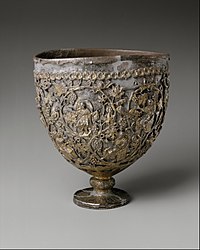
Biblical era
[edit]From "The Acts of the Apostles", Chapter 11 Verse 26
“And when he had found him, he brought him unto Antioch. And it came to pass, that a whole year they assembled themselves with the church, and taught much people. And the disciples were called Christians first in Antioch.”
Rashidun period
[edit]
In 637, during the reign of the Byzantine emperor Heraclius, Antioch was conquered by the Rashidun Caliphate during the Battle of the Iron Bridge. The city became known in Arabic as أنطاكية (ʾAnṭākiya). Since the Umayyad Caliphate was unable to penetrate the Anatolian plateau, Antioch found itself on the frontline of the conflicts between two hostile empires during the next 350 years, so that the city went into a precipitous decline. After the demise of Umayyad rule, Antioch became part of the Abbasid empire (except for a brief rule of the Tulunids[12]), Ikhshidids and Hamdanids.
In 969, the city was reconquered for the Byzantine Emperor Nikephoros II Phokas by Michael Bourtzes and the stratopedarches Peter. It soon became the seat of a dux, who commanded the forces of the local themes and was the most important officer on the Empire's eastern border,[citation needed] held by such men as Nikephoros Ouranos. In 1078, Philaretos Brachamios, an Armenian hero, seized power. He held the city until the Seljuk Turks captured it from him in 1084. The Sultanate of Rum held it only fourteen years before the Crusaders arrived.[13]
Crusader era
[edit]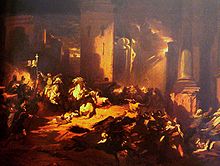

The Crusaders' Siege of Antioch between October 1097 and June 1098 during the First Crusade resulted in its fall. The Crusaders caused significant damage, including a massacre of its population, both Christian and Muslim.[14] Following the defeat of Seljuk forces arriving with the aim to break the siege only four days after its capture by the crusaders, Bohemond I became its overlord.[14] It remained the capital of the Latin Principality of Antioch for nearly two centuries.
In 1268 it fell to the Egyptian Mamluk Sultan Baybars after another siege. Baibars proceeded to massacre the Christian population.[15] In addition to suffering the ravages of war, the city lost its commercial importance because trade routes to East Asia moved north following the 13th-century Mongol conquests. Antioch never recovered as a major city, with much of its former role falling to the port city of Alexandretta (İskenderun). An account of both cities as they were in 1675 appears in the diary of the English naval chaplain Henry Teonge.
Ottoman city
[edit]This section needs expansion. You can help by adding to it. (July 2015) |

The city was initially the centre of the Sanjak of Antakya, part of the Damascus Eyalet. It was laterly centre of Sanjak of Antakya in Aleppo Eyalet. It was finally kaza centre in Sanjak of Aleppo, part of Aleppo Vilayet.
In 1822 (and again in 1872), Antakya was hit by an earthquake and damaged. When Egyptian general Ibrahim Pasha established his headquarters in the city in 1835, it had only some 5,000 inhabitants. Supporters hoped the city might develop thanks to the Euphrates Valley Railway, which was supposed to link it to the port of Sueida (now Samandağı), but this plan never came to fruition. This scheme is the subject of Letitia Elizabeth Landon's poem ![]() Antioch. (1836) in which she reflects of the superiority of trade and commerce over war and conflict. The city suffered repeated outbreaks of cholera due to inadequate infrastructure for sanitation.[13] Later the city developed and rapidly resumed much of its old importance when a railway was built along the lower Orontes Valley.
Antioch. (1836) in which she reflects of the superiority of trade and commerce over war and conflict. The city suffered repeated outbreaks of cholera due to inadequate infrastructure for sanitation.[13] Later the city developed and rapidly resumed much of its old importance when a railway was built along the lower Orontes Valley.
French Mandate and Turkish annexation
[edit]Antioch was part of the Sanjak of Alexandretta during the Mandate for Syria and the Lebanon, until it was made the Hatay State in 1938, after Turkish pressure.[16] An Arab nationalist newspaper in the city, run by Zaki al-Arsuzi, was shut down by the Turks.[citation needed] On May 30, 1938, an Arab was killed during a riot by a Turkish crowd.[17] On 7 July 1938, the Turkish army entered Antioch.[17] The annexation of the Hatay State by Turkey in 1939, creating the Hatay Province, caused an exodus of Christians and Alawites from Antioch east to the French Mandate.
The district Antakya was created in 2013 from part of the former central district of Hatay.[18][19]
Demographics
[edit]Language
[edit]A British traveller visiting Antakya in 1798 reported that generally, Turkish was spoken, while, by contrast, the prevalent language in Aleppo at the time was Arabic.[20] Most Alawites and Armenians spoke Turkish as a second language.[21]
Religion
[edit]In 1935, Turkish and Arab Muslims made more than 80% of the population.
| Religion | Population (Percentage) |
|---|---|
| Sunni Muslims | 19,720 (58%)[22] |
| Alawites | 8,670 (25.5%)[22] |
| Christians | 4,930 (14.5%)[22] |
| Others | 680 (2%) |
| Total | 34,000 (100%)[22] |
Antakya was home to one of the most ancient Jewish communities for over 2,200 years.[23]
Recent history
[edit]
Mount Habib-i Neccar (Habib An-Najar in Sura al-Yassin 36:13) and the city walls which climb the hillsides symbolise Antakya, making the city a formidable fortress built on a series of hills running north-east to south-west. Antakya was originally centred on the east bank of the river. Since the 19th century, the city has expanded with new neighbourhoods built on the plains across the river to the south-west, and four bridges connect the old and new cities. Many of the buildings of the last two decades are styled as concrete blocks, and Antakya has lost much of its classic beauty.[citation needed] The narrow streets of the old city can become clogged with traffic.
Antakya is a provincial capital of considerable importance as the centre of a large district. The draining of Lake Amik and development of land have caused the region's economy to grow in wealth and productivity. The town is a lively shopping and business centre with many restaurants, cinemas and other amenities. This district is centred on a large park opposite the governor's building and the central avenue Kurtuluş Caddesı. The tea gardens, cafes and restaurants in the neighbourhood of Harbiye are popular destinations, particularly for the variety of meze in the restaurants. The Orontes River can be malodorous when water is low in summer. Rather than formal nightlife, in the summer heat, people will stay outside until late at the night to walk with their families and friends, and munch on snacks.

Its location near the Syrian border makes Antakya more cosmopolitan than many cities in Turkey. It did not attract the mass immigration of people from eastern Anatolia in the 1980s and 1990s that radically swelled the populations of Mediterranean cities such as Adana and Mersin. Both Turkish and Arabic are still widely spoken in Antakya, although written Arabic is rarely used. A mixed community of faiths and denominations co-exist peacefully here. While almost all the inhabitants are Muslim, a substantial proportion adhere to the Alevi and Alawite traditions, in 'Harbiye' there is a place to honour the saint Hızır. Numerous tombs of saints, of both Sunni and Alawite, are located throughout the city. Several small Christian communities are active in the city, with the largest church being St. Peter and St. Paul on Hürriyet Avenue.[24] With its long history of spiritual and religious movements, Antakya is a place of pilgrimage for Christians. The Jewish community of Antakya had shrunk to 14 members in 2014.[25][26] In 2023, the last Jew in the city announced that he was leaving the city after a devastating earthquake.[27]
It has a reputation in Turkey as a place for spells, fortune telling, miracles and spirits.[citation needed]
Local crafts include a soap scented with the oil of bay tree.

2023 earthquakes
[edit]
On 6 February 2023, Antakya suffered heavy damage as a result of a major earthquake.[28] Many parts of the city were totally destroyed.[29] As of 7 February, the BBC reported that at least 1,200 buildings in the city center and the districts of Kırıkhan and İskenderun were razed. Officials said "almost all" houses in the Cebrail District had collapsed.[30] Many historical sites, including churches and mosques, were destroyed,[31] St. Paul's Church being one of them.[32] The historic Antakya Synagogue and Hatay State Assembly Building were also destroyed.[33][34]
In the aftermath, President Recep Tayyip Erdogan promised to an immediate reconstruction of the affected areas. During a visit to the city in September 2023, The New York Times reported that heavily buildings were still being demolished and no large-scale reconstruction works were observed. Many damaged buildings remained standing but abandoned while survivors continue to live in tents. Hatay's mayor, Lutfu Savas, said only half of the estimated 38,000 buildings registered to be dismantled had been fulfilled. In Gülderen, there were ongoing works to build 2,300 apartment units in 122 blocks.[29]
Geography
[edit]Antakya is located on the banks of the Orontes River (Turkish: Asi Nehri), approximately 22 km (14 mi) inland from the Mediterranean coast. The city is in a valley surrounded by mountains, the Nur Mountains (ancient Amanos) to the northwest and Mount Keldağ (Jebel Akra) to the south, with the 440 m high Mount Habib-i Neccar (the ancient Mount Silpius) forming its eastern limits. The mountains are a source of a green marble. Antakya is at the northern edge of the Dead Sea Rift and vulnerable to earthquakes.
The plain of Amik to the north-east of the city is fertile soil watered by the Orontes, the Karasu and the Afrin rivers; the lake in the plain was drained in 1980 by a French company. At the same time channels were built to widen the Orontes and let it pass neatly through the city centre. The Orontes is joined in Antakya by the Hacı Kürüş stream to the north-east of the city near the church of St Peter, and the Hamşen which runs down from Habib-i Neccar to the south-west, under Memekli Bridge near the army barracks. Flora includes the bay trees and myrtle.
Composition
[edit]There are 95 neighbourhoods in Antakya District:[35]
- Açıkdere
- Akasya
- Akçaova
- Akcurun
- Akevler
- Akhisar
- Aksaray
- Alaattin
- Alahan
- Alazı
- Altınçay
- Anayazı
- Apaydın
- Arpahan
- Aşağıoba
- Avsuyu
- Aydınlıkevler
- Bağrıyanık
- Barbaros
- Biniciler
- Bitiren
- Boşin
- Bozhüyük
- Büyükdalyan
- Cebrail
- Cumhuriyet
- Demirköprü
- Derince
- Dikmece
- Doğanköy
- Dutdibi
- Ekinci
- Emek
- Esenlik
- Esentepe
- Fevziçakmak
- Gazi
- Gazipaşa
- General Şükrü Kanatlı
- Gökçegöz
- Gülderen
- Güllübahçe
- Günyazı
- Güzelburç
- Habib-i Neccar
- Hacı Ömer Alpagot
- Haraparası
- Hasanlı
- Havuzlar
- İplik Pazarı
- Kantara
- Karaali
- Karaalibölüğü
- Kardeşler
- Karlısu
- Kisecik
- Kışla Saray
- Kocaabdi
- Küçükdalyan
- Kuruyer
- Kuyulu
- Kuzeytepe
- Madenboyu
- Mansurlu
- Maraşboğazı
- Maşuklu
- Melekli
- Meydan
- Narlıca
- Odabaşı
- Oğlakören
- Orhanlı
- Ovakent
- Paşaköy
- Saçaklı
- Saraycık
- Saraykent
- Şehitler
- Serinyol
- Şeyhali
- Şirince
- Sofular
- Suvatlı
- Tahtaköprü
- Tanışma
- Üçgedik
- Ulucami
- Ürgenpaşa
- Üzümdalı
- Uzunaliç
- Yaylacık
- Yenicami
- Yeşilova
- Zenginler
- Zülüflühan
Climate
[edit]Antakya's climate is classified as hot-summer Mediterranean (Köppen: Csa) or dry-summer humid subtropical (Trewartha: Cf or wet Cs). The city experiences hot, dry summers, and mild, wet winters; though its higher altitude allows for lower temperatures than the coast.
Highest recorded temperature:45.2 °C (113.4 °F) on 13 August 2023
Lowest recorded temperature:−11.8 °C (10.8 °F) on 14 January 1950
| Climate data for Antakya (1991–2020, extremes 1940–2023) | |||||||||||||
|---|---|---|---|---|---|---|---|---|---|---|---|---|---|
| Month | Jan | Feb | Mar | Apr | May | Jun | Jul | Aug | Sep | Oct | Nov | Dec | Year |
| Record high °C (°F) | 20.5 (68.9) |
26.6 (79.9) |
30.5 (86.9) |
37.5 (99.5) |
42.5 (108.5) |
43.2 (109.8) |
44.6 (112.3) |
45.2 (113.4) |
43.5 (110.3) |
39.2 (102.6) |
32.5 (90.5) |
25.1 (77.2) |
45.2 (113.4) |
| Mean daily maximum °C (°F) | 12.5 (54.5) |
14.9 (58.8) |
19.0 (66.2) |
23.0 (73.4) |
27.0 (80.6) |
29.7 (85.5) |
31.6 (88.9) |
32.5 (90.5) |
31.4 (88.5) |
28.2 (82.8) |
20.3 (68.5) |
13.9 (57.0) |
23.7 (74.7) |
| Daily mean °C (°F) | 8.2 (46.8) |
9.9 (49.8) |
13.6 (56.5) |
17.4 (63.3) |
21.6 (70.9) |
25.1 (77.2) |
27.6 (81.7) |
28.3 (82.9) |
26.1 (79.0) |
21.5 (70.7) |
14.3 (57.7) |
9.5 (49.1) |
18.6 (65.5) |
| Mean daily minimum °C (°F) | 5.0 (41.0) |
5.9 (42.6) |
9.1 (48.4) |
12.6 (54.7) |
16.9 (62.4) |
21.3 (70.3) |
24.4 (75.9) |
25.2 (77.4) |
21.7 (71.1) |
16.2 (61.2) |
9.8 (49.6) |
6.2 (43.2) |
14.5 (58.1) |
| Record low °C (°F) | −11.8 (10.8) |
−6.8 (19.8) |
−4.2 (24.4) |
1.5 (34.7) |
7.7 (45.9) |
11.6 (52.9) |
15.9 (60.6) |
15.4 (59.7) |
7.9 (46.2) |
2.3 (36.1) |
−3.0 (26.6) |
−6.6 (20.1) |
−11.8 (10.8) |
| Average precipitation mm (inches) | 198.4 (7.81) |
165.2 (6.50) |
142.9 (5.63) |
101.9 (4.01) |
80.9 (3.19) |
30.9 (1.22) |
16.0 (0.63) |
17.5 (0.69) |
41.6 (1.64) |
76.6 (3.02) |
99.6 (3.92) |
182.0 (7.17) |
1,154.2 (45.44) |
| Average precipitation days | 15.11 | 13.21 | 13.17 | 8.98 | 5.54 | 2.15 | 0.6 | 0.64 | 3.35 | 7.2 | 8.93 | 13.5 | 92.4 |
| Average relative humidity (%) | 74.0 | 69.9 | 67.4 | 67.1 | 66.7 | 67.3 | 69.7 | 69.9 | 66.0 | 64.0 | 66.5 | 74.8 | 68.6 |
| Mean monthly sunshine hours | 105.4 | 130.0 | 186.0 | 219.0 | 282.1 | 321.0 | 344.1 | 319.3 | 276.0 | 217.0 | 150.0 | 102.3 | 2,652.2 |
| Mean daily sunshine hours | 3.4 | 4.6 | 6.0 | 7.3 | 9.1 | 10.7 | 11.1 | 10.3 | 9.2 | 7.0 | 5.0 | 3.3 | 7.3 |
| Source 1: Turkish State Meteorological Service[36] | |||||||||||||
| Source 2: NOAA (humidity)[37] | |||||||||||||
Education
[edit]Mustafa Kemal University, abbreviated as MKU, has several faculties including Engineering and Medicine, while having a campus called Tayfur Sökmen located in Serinyol district 15 km (9.3 mi), north of Antakya (centrum). Established in 1992, currently more than 32,000 students enrolled at the university.[38]
Besides the campus in Serinyol, MKU has its faculties spread out in all main districts of the province including Altınözü, Antakya, Belen, Dörtyol, Erzin, Hassa, İskenderun, Kırıkhan, Reyhanlı, Samandağ and Yayladağı.
Main sights
[edit]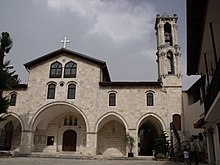

The long and varied history has created many architectural sites of interest. There is much for visitors to see in Antakya, although many buildings have been lost in the rapid growth and redevelopment of the city in recent decades.
- Hatay Archaeology Museum has the second largest collection of Roman mosaics in the world.
- The rock-carved Church of St Peter, with its network of refuges and tunnels carved out of the rock, a site of Christian pilgrimage. There are also tombs cut into the rock face at various places along the Orontes valley.
- Old market district: It offers plenty of traditional shops, where you can explore what you have not seen before. It is exactly in the city centre, you are in when you see the sign Uzun Çarşı Caddesi.
- The seedy Gündüz cinema in the city centre was once used as parliament building of the Republic of Hatay.
- The waterfalls at the Harbiye / Daphne promenade.
- The Ottoman Habib'i Neccar Mosque, the oldest mosque in Antakya and one of the oldest in Anatolia.
- The labyrinth of narrow streets and old Antakya houses. This district is the oldtown in fact.
- Vespasianus Titus Tunnel-Samandagı. It is approximately 35 km. far from the centre.
- Beşikli Cave and Graves (the antique city of Seleukeia Pierria)
- St. Simon Monastery
- Bagras (Bakras) Castle, which was built in antiquity and restored many times in later centuries (particularly during the Crusades, when it was a stronghold of the Knights Templar), served as a watchtower on the 27 km (17 mi) mountain road from İskenderun (Alexandretta) to Antakya (Antioch).
- The panoramic view of the city from the heights of Mount Habib-i Neccar
- St. Paul Orthodox Church
With its rich architectural heritage, Antakya is a member of the Norwich-based European Association of Historic Towns and Regions.[39] The Roman bridge (thought to date from the era of Diocletian) was destroyed in 1972 during the widening and channelling of the Orontes.[citation needed]
-
Antakya Yeni Camii Exterior
-
Antakya Habib-i Neccar Camii Interior
-
Antakya Habib-i Neccar Camii Exterior
-
Antakya Sarimiye Mosque Minaret
-
Antakya Ulu Cami Entrance to courtyard
-
Antakya Ulu Cami
-
Antakya Ulu Cami
-
View of the river in the 1780s, by Louis-François Cassas.
-
Medina gate in the 1780s, by Louis-François Cassas.
-
Ruins of the Seleucus palace in the 1780s, by Louis-François Cassas.
-
Mosaics of Eros are standing on the wings of two Psyches and whipping them on in Hatay Archaeology Museum
-
Dionysus mosaic in Hatay Archaeology Museum
Transport
[edit]The city is served from Hatay Airport.
Sports
[edit]Antakya has one male professional football club, Hatayspor, who play in the Süper Lig. There is also a female professional team called Hatay Büyükşehir Belediyesi. Hatay Büyükşehir Belediyespor, a woman's basketball team, is also present, and plays in the Turkish Women's Basketball League.
Cuisine
[edit]The cuisine of Antakya is renowned. Its cuisine is considered Levantine rather than Turkish. The cuisine offers plenty of meals, where beef and lamb are mainly used. Popular dishes include the typical Turkish kebab, served with spices and onions in flat unleavened bread, with yoghurt as ali nazik kebab, oruk, kaytaz böreği and katıklı ekmek. Hot, spicy food is a feature of this part of Turkey, along with Turkish coffee and local specialties. Here are some savoury foods:
- İçli köfte and other oruk varieties: varieties of the Arabic kibbeh, deep-fried balls of bulgur wheat stuffed with minced meat; or baked in ovens in cylinder-cone shape. Saç oruğu is made of the same ingredients, however in circular shape.
- Kaytaz böreği: It is patty that is made of wheat, beef, tomato and onion.
- Katıklı ekmek: Ingredients in Katıklı Ekmek usually consist of wheat, traditional pepper (paste), spices such as sesame and theme, çökelek or cheese. It looks like an ancestor of pizza. Not a lot of restaurants serve it, however it can be found in old-market that is located in the centre and Harbiye.
- Pomegranate syrup, used as a salad dressing, called debes ramman, a traditional Levantine Arabic dressing.
- Semirsek, a thin bread with hot pepper, minced meat or spinach filling
- Spicy chicken, a specialty of Harbiye
- Za'atar (Zahter) a traditional Levantine Arabic paste of spiced thyme, oregano, and sesame seeds, mixed with olive oil, spread on flat (called pide or in English pita) bread.
- Fresh chick peas, munched as a snack.
- Hirise, boiled and pounded wheat meal.
- Aşur, meat mixed with crushed wheat, chickpea, cumin, onion, pepper and walnut
- Hummus - the chick-pea dip
- pureed fava beans
- Patlıcan salatası: Patlıcan salatası or babaganoush, made of baked and sliced aubergines that mixed with pepper and tomato. It is usually served with pomegranate syrup.
- Taratur: Known also as Tarator, made of walnuts, 'tahin', yoghurt and garlic.
- Süzme yoğurt: A type of yoghurt that its water content is removed with traditional methods.
- Ezme biber: It is made of pepper and walnuts.
- Surke - dried curds served in spicy olive oil
- Çökelek - the spicy sun-dried cheese
- Eels from the Orontes, spiced and fried in olive oil
- Sweets/desserts
- Künefe - a hot cheese, kadaif-based sweet. Antakya is Turkey's künefe capital; the pastry shops in the centre compete to claim being kings Turkish: kral of the pastry.[citation needed]
- Müşebbek - rings of deep fried pastry.
- Peynirli irmik helvası - Peynirli İrmik Helvası is a dessert that is made of semolina, sugar and traditional cheese that is the same as used in künefe. It is served warm, especially in restaurants in the region Harbiye, rather than künefe shops that are located in the centre.
Twin towns
[edit]Antakya is twinned with:
 Aalen, Germany (since 1995).
Aalen, Germany (since 1995).
Notable people
[edit]- Alexandros (1st century BC) Greek sculptor
- George of Antioch
- Ignatius of Antioch, Patriarch of Antioch
- John Chrysostom (349–407) Patriarch of Constantinople
- Saint Luke, first century AD, Christian evangelist and author of the Gospel of St. Luke and Acts of the Apostles
- Yağısıyan, Seljukid governor of the city up to its capture by the Crusaders
- Selâhattin Ülkümen - Righteous among the nations
- Tayfur Sökmen - The president of the Republic of Hatay during its existence between the years 1938 and 1939.
References
[edit]- ^ Jump up to: a b "Address-based population registration system (ADNKS) results dated 31 December 2022, Favorite Reports" (XLS). TÜİK. Retrieved 19 September 2023.
- ^ Nakib, Bülent (2004). Antakya ağzı: dilbilgisi ve sözlük (in Turkish). Hatay Folklor Araştırmaları Derneği. p. 43.
Anteke : Antakya adının Antakya ağzında söyleniş biçimi
- ^ Büyükşehir İlçe Belediyesi, Turkey Civil Administration Departments Inventory. Retrieved 19 September 2023.
- ^ "İl ve İlçe Yüz ölçümleri". General Directorate of Mapping. Retrieved 19 September 2023.
- ^ "The mixture of Roman, Greek, and Jewish elements admirably adapted Antioch for the great part it played in the early history of Christianity. The city was the cradle of the church." — "Antioch," Encyclopaedia Biblica, Vol. I, p. 186 (p. 125 of 612 in online .pdf file. Warning: Takes several minutes to download).
- ^ "Acts 11:26 - The Church at Antioch". Bible Hub.
- ^ Gregg, Heather Selma (January 2014). The Path to Salvation: Religious Violence from the Crusades to Jihad. ISBN 9781612346618.
- ^ Jump up to: a b Roberson, Ronald (1995). The Eastern Christian Churches: A Brief Survey. ISBN 9788872103104.
- ^ Cecilia Gaposchkin, M. (17 January 2017). Invisible Weapons: Liturgy and the Making of Crusade Ideology. ISBN 9781501707971.
- ^ Borges, Anelise (2023-02-10). "'Antakya is finished': Thousands left homeless in ruined city". euronews. Retrieved 2023-02-12.
- ^ "Lütfü Savaş: Hatay'da 20 bin kişi öldü, 24 bin yaralı vartrans-title=Lütfü Savaş: 20 thousand people died and 24 thousand were injured in Hatay" (in Turkish). Artı Gerçek. 18 February 2023. Retrieved 18 November 2023.
- ^ "Ahemed b. Tolun".
- ^ Jump up to: a b Rockwell 1911, p. 131.
- ^ Jump up to: a b Burns, Ross (2013). Aleppo, A History. Routledge. pp. 109–111. ISBN 9780415737210.
- ^ "History of Armenia by Vahan Kurkjian – Chapter 30". penelope.uchicago.edu.
- ^ Shields, Sarah D. (2011-03-16). Fezzes in the River: Identity Politics and European Diplomacy in the Middle East on the Eve of World War II. Oxford University Press. ISBN 978-0-19-979300-6.
- ^ Jump up to: a b De Giorgi, Andrea U.; Eger, A. Asa (2021). Antioch: A History. London: Routledge. pp. 504–505. ISBN 9781317540410.
- ^ "Law No. 6360". Official Gazette (in Turkish). 6 December 2012.
- ^ "İl İdaresi ve Mülki Bölümler Şube Müdürlüğü İstatistikleri - İl ve İlçe Kuruluş Tarihleri" (PDF) (in Turkish). p. 39. Retrieved 20 September 2023.
- ^ Travels in Africa, Egypt, and Syria, from the Year 1792 to 1798, by William George Browne, year 1806 on page 449 (and page 442 for Aleppo).
- ^ Jump up to: a b Dumper, Michael (2007). Cities of the Middle East and North Africa: A Historical Encyclopedia. ABC-CLIO. p. 40. ISBN 9781576079195.
- ^ Jump up to: a b c d e Go, Julian (2013). Decentering Social Theory. Emerald Group Publishing. p. 31. ISBN 9781781907276.
- ^ "Last Jew Of Antakya, A 2,300-Year-Old Jewish Community, Puts On Tefillin And Says 'I'm Leaving'". VINnews. Vos Iz Neias?. 20 February 2023. Retrieved 20 February 2023.
- ^ "Christian Arab Congregation In Antakya, Turkey". Edge of Humanity Magazine. 7 February 2017.
- ^ Чудакофф, Даня (14 мая 2014 г.). «Еврейская община Турции жаждет прошлого» . Альджазера . Получено 18 февраля 2018 года .
- ^ Avotaynu: Международный обзор еврейской генеалогии, том 14, G. Mokotoff, 1998, p. 40
- ^ Рахав-Мейр, Сиван (20 февраля 2023 г.). «Последний еврей Антакья» . Израильские национальные новости . Получено 20 февраля 2023 года .
- ^ «Землетрясение в Турции: Би -би -си сообщает от Антакья, город, превращенный в обломки» . Би -би -си . Получено 8 февраля 2023 года .
- ^ Jump up to: а беременный Хаббард, Бен; Кирак, Ниме (1 октября 2023 г.). «Древний город, теперь в руинах, изо всех сил пытается сохранить свою душу» . New York Times . Получено 18 ноября 2023 года .
- ^ « « Есть почти 2000 разрушенных зданий, наши потери слишком много . Последняя ситуация в Хайэй: BBC News (на турецком). 6 февраля 2023 года . Получено 7 февраля 2023 года .
- ^ «Азия/Турция - Антиохия, землетрясение разрушает мечети и церкви. Католический приход приветствует перемещенных людей» . Агензия Фиды . Получено 8 февраля 2023 года .
- ^ GCT (2023-02-07). «Историческая греческая православная церковь Антакья в Хайэй, поврежденная землетрясением» . Получено 2023-02-09 .
- ^ «Землетрясение в Турции: 2500-летняя еврейская присутствие в Антакья может подойти к концу» . Ближний Восток глаз . Получено 2023-02-15 .
- ^ «Разрушение в Хайэй было отражено в объективе репортера пресс -секретаря» . sozcu.com.tr (на турецком). 7 февраля 2023 года. Архивировано с оригинала 7 февраля 2023 года . Получено 7 февраля 2023 года .
- ^ Махалле , инвентарь гражданского администрирования Турции. Получено 19 сентября 2023 года.
- ^ «Официальная статистика: страны Наций наших провинций (1991–2020 годы)» (на турецком). Метеорологическая служба турецкого государства . Получено 28 июня 2021 года .
- ^ «Всемирная метеорологическая организация Климатические нормы за 1991-2020 гг.-Антакья» (CSV) . Национальное управление океанического и атмосферного . Получено 17 июля 2024 года .
- ^ «О Университете Мустафы Кемал (MKU)» . Мку . Получено 2011-03-26 .
- ^ Ассоциация исторических городов Турция
- Гланвилл Дауни (1963). Древняя Антиохия . ПРИЗНАЯ УНИВЕРСИТЕТА ПРИСЕТА .
- Роквелл, Уильям Уокер (1911). . В Чисхолме, Хью (ред.). Encyclopædia Britannica . Тол. 2 (11 -е изд.). Издательство Кембриджского университета. С. 130–132.
Внешние ссылки
[ редактировать ]- Анкайя
- Антакья Район
- Заселенные места в провинции Хатай
- Кукурова
- Археологические места в провинции Хатай
- Заселенные места вдоль шелковой дороги
- Крестовые места
- Древнегреческие археологические места в Турции
- Колонии селевки в Анатолии
- Святые города
- Новозаветные места
- Римские сайты в Турции
- Заселенные места, установленные в 4 веке до нашей эры
- Еврейские общины в Турции
- 300 -е годы до н.э. заведения
- Арабские поселения в Турции
- Алеппо провинция
- Заселенные места разрушены землетрясениями
- Districts of Hatay Province
- Муниципалитеты столичного района в Турции







